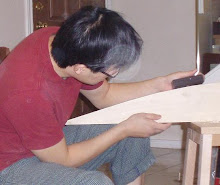
All the tools I'll need to do a decent job of woodworking is in this picture. They are stored in this giant tool box I had frankensteined together. It's not a pretty visual, but in a two hundred square foot room, it's poetry. Sometimes, I feel I could work with a whole lot less tools, and other times, more would be nice. There are more an than tools in this cabinet, there are the not so glamorous accessories equally important in woodworking. These are assortments of sharpening stones, glue, screws, measuring, marking devices, jigs, clamps, wood finishes, waxes, applicators and reference books.
The key to building efficiently is that you should be able to get to these things you quickly, so a loose organization system is very important. By loose, I mean I know where they are and that's pretty much it. I am by no means an organized person. I really don't believe in spending my time cleaning when I could use it to make a mess and build something.

When doors to my tool box are closed, the cabinet looks like a bunch of mixed match boxes set on top of each other. As my wood working skills develop, this tool box will change to suit my needs. Right now it is unrefined and a little sloppy looking, but it's okay because it's a work in progress.
 When I do wood working in the living room, I have to minimize any power tool usage. That's why I prefer the hand saw and the chisels. But when there's lots of ply wood to cut for the cabinet carcass, then the circular saw will have to come out. I use the Festool plunge circular saw. You can go the the Festool link and see all their product. They charge a premium for their product but they are incredibly well engineered product. The saw has a 95% dust extraction capability, is designed to be very safe and accurate. I connect this saw to my Eletrolux vacuum cleaner with a HEPA filter. The two are linked by an auto switch which turns on the vacuum when the saw turned on and off 7 seconds after the saw is turned off. Festool also makes an incredible Dust extractor, but I can't afford that right now.
When I do wood working in the living room, I have to minimize any power tool usage. That's why I prefer the hand saw and the chisels. But when there's lots of ply wood to cut for the cabinet carcass, then the circular saw will have to come out. I use the Festool plunge circular saw. You can go the the Festool link and see all their product. They charge a premium for their product but they are incredibly well engineered product. The saw has a 95% dust extraction capability, is designed to be very safe and accurate. I connect this saw to my Eletrolux vacuum cleaner with a HEPA filter. The two are linked by an auto switch which turns on the vacuum when the saw turned on and off 7 seconds after the saw is turned off. Festool also makes an incredible Dust extractor, but I can't afford that right now.
 To make it even safer, I also have a portable HEPA air cleaner in the room when I work and finally I modified the air return on the HVAC system to accept a larger quality air filter. This protects the central air system from any wood dust left.
To make it even safer, I also have a portable HEPA air cleaner in the room when I work and finally I modified the air return on the HVAC system to accept a larger quality air filter. This protects the central air system from any wood dust left.












